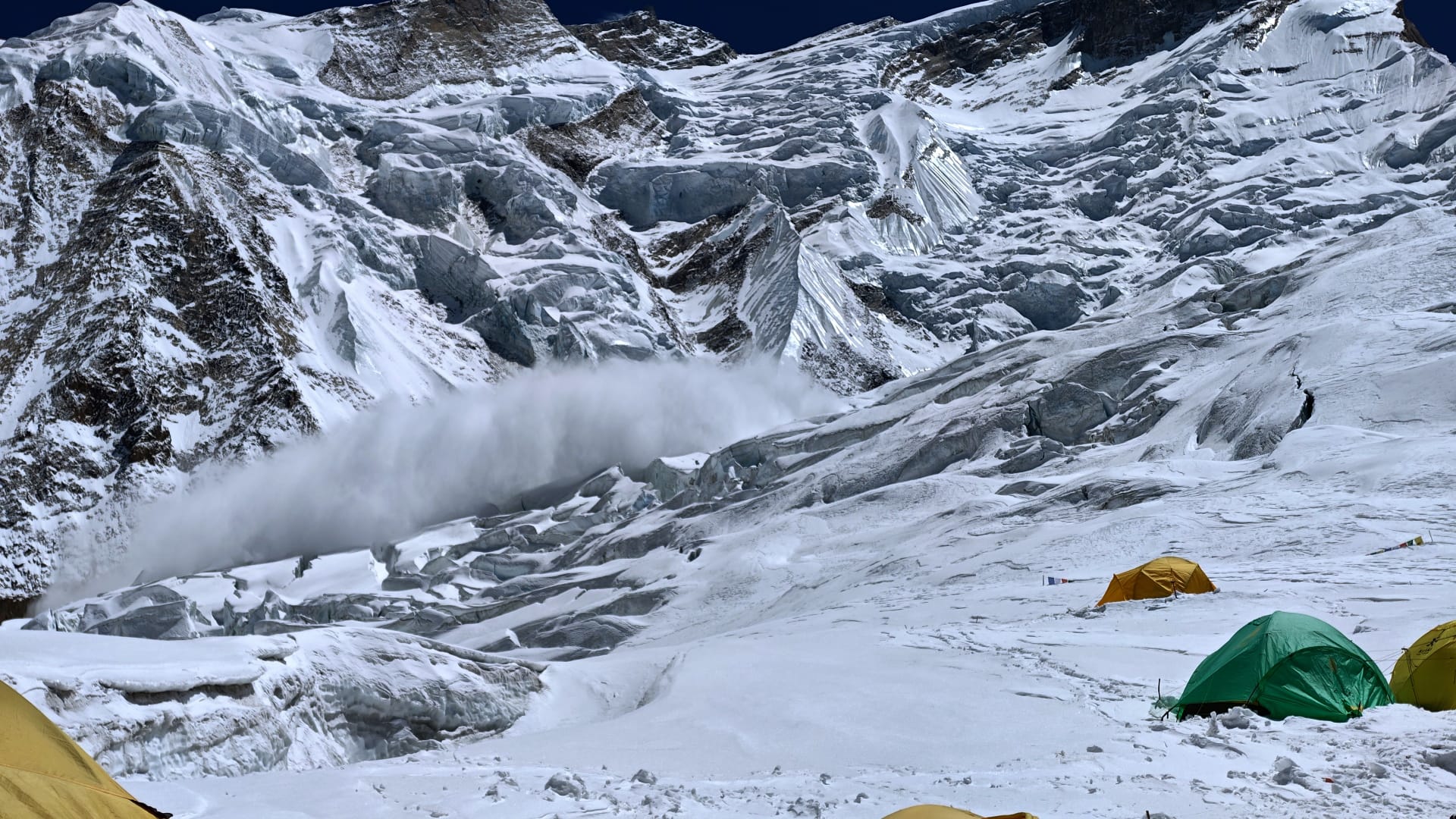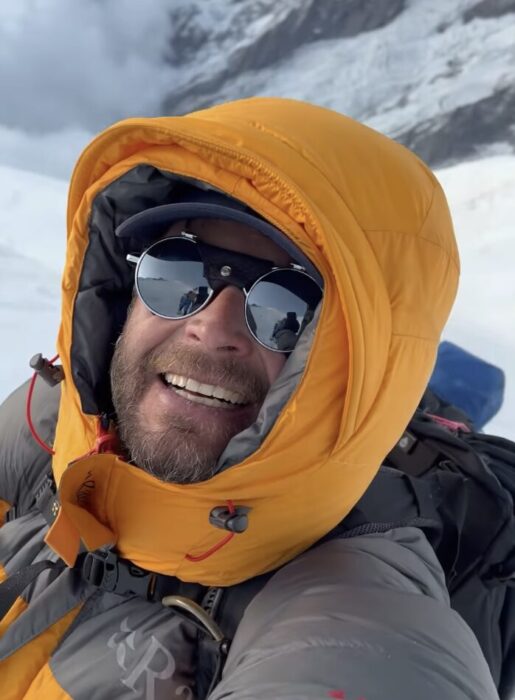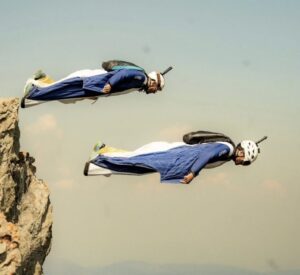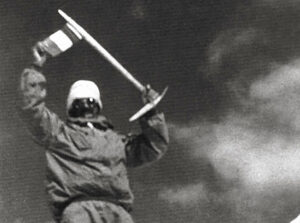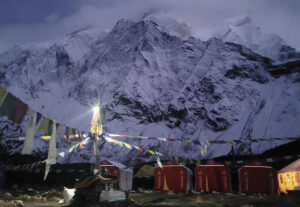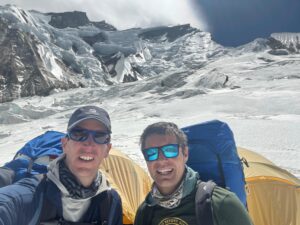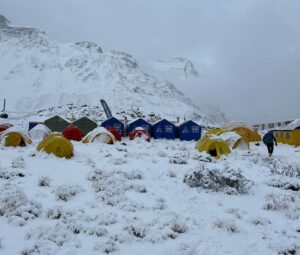More climbers have been evacuated from Camp 3 at 6,400m on Annapurna, after a second summit push on the mountain failed because of too much snow.
Moeses Fiamoncini, on his fifth attempt on Annapurna, and his client Renata Fialho, both from Brazil, helicoptered down from Camp 3 in difficult straits.
“I was exhausted, with signs of pulmonary edema, and Renata, although using oxygen, experienced hallucinations,” he wrote. He told ExplorersWeb that their descent could have ended badly.
Pilot Simone Moro has also posted a video describing how he landed his helicopter on a very small spot in high winds:
The growing number of high-altitude evacuations should be a topic for debate.
ExplorersWeb has gathered a complete account of this latest event from Moeses Fiamoncini and from independent climber Piotr Krzyzowski. One insurance company that deals with these rescues has also offered insight.
The second summit push
Piotr Krzyzowski of Poland, 45, was in the group of climbers who formed the season’s second summit push on Annapurna. He climbed independently, with no personal Sherpa or bottled oxygen.
Krzyzowski’s main goal this season is Makalu. First, he acclimatized on Himlung Himal (7,126m), where he climbed completely alone, carrying his small tent and checking the route with a GPS. He reached 6,700m where one meter of fresh snow stopped him. He then moved on to Annapurna Base Camp, where he arrived on April 17. That same day, he joined the summit push.
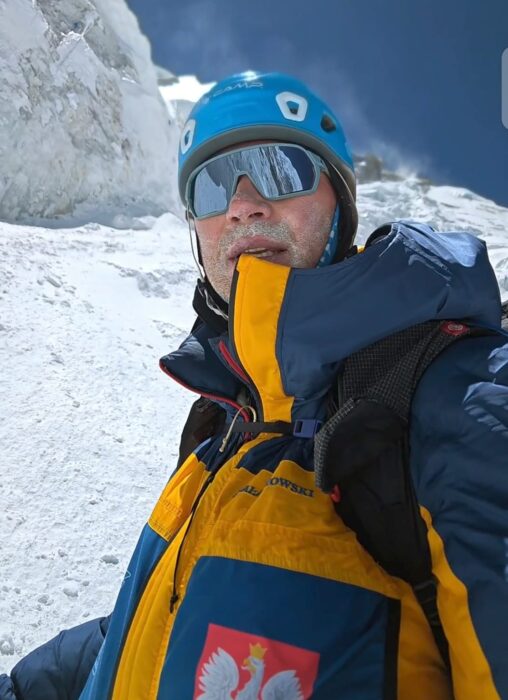
Piotr Krzyzowski of Poland on Annapurna last weekend. Photo: Piotr Krzyzowski
The Polish climber made it to Camp 1 that first day and Camp 2 on April 18. Early on April 19, he crossed the dangerous couloir and reached Camp 3 but kept on going. He wanted to pitch his tent as close as possible to the usual location of Camp 4.
“Normally, the section between Camp 3 and Camp 4 takes four hours, but I needed over eight hours to reach 7,000m, where I pitched my tent below a serac,” he told ExplorersWeb. “On the way to Camp 4, I crossed a group of people on oxygen, going down. They had been pushing for the summit for more than 24 hours, but no one succeeded because of the poor conditions.”
Added Krzyzowski: “Moeses [Fiamoncini] was among them, along with his client [Renata Fialho]. He told me he was having a very difficult time and he was in dire need of some supplementary oxygen or he would die.”
Fiamoncini told the Pole that the push from Camp 3 had been extremely long. Climbers had to wait for Sherpas to fix some difficult sections, break trail, and look for the right route.
Meanwhile, Krzyzowski spent that night in his tent, showered with snow from the serac above.
“I had a tough night, knife in hand, ready to cut the tent open and escape if something happened,” he said.
When he tried to set off again, the trail had disappeared. He decided to turn around.
“My life is more important than a summit,” he said.
He descended by following a GPS track. There was no trail.
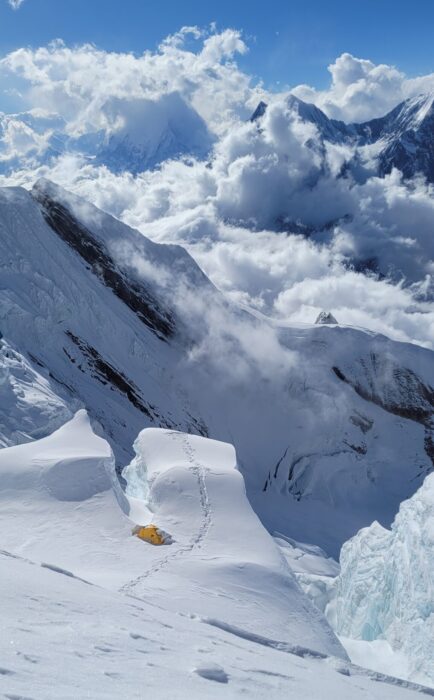
The two Brazilians’ tent at Camp 3 on April 18. Photo: Renata Fialho
Fiamoncini’s account
Moeses Fiamoncini and Renata Fialho are recovering in a Kathmandu hotel. The Brazilian described their climb to ExplorersWeb.
“Including the Sherpas, I believe there were about 24 people attempting the summit during this second push,” he said.
Fiamoncini and Fialho left Camp 3 (6,400m) at 3:30 pm.
“Right from the start, it was very challenging due to the amount of snow,” he said. “I’ve attempted Annapurna four times in the past four years, and I noticed that the route up from Camp 3 has changed a lot. Before, there were just a few seracs and some 90-degree ice walls to climb. This time, there were many more. The glacier has changed significantly and become more difficult, especially with the snow that had been accumulating since April 9.”
Video: Fiamoncini above Camp 3 on Annapurna
“The climb up to Camp 4 at 7,000m wasn’t too difficult, but there was still deep snow, often above the knees,” Fiamoncini said. “The wind picked up as the evening approached, and after sunset, strong gusts started.”
The Brazilian, who usually climbs only with base camp logistics, was leading a private client and had two personal Sherpas: brothers Dawa Nurbu Sherpa and Lakpa Sherpa. He also had an available bottle of supplementary oxygen.
“I had the bottle ready to use if I felt I wouldn’t be able to keep up with my client [Renata Fialho], or in case of a rescue involving her,” he explained.
Things go south
“The most difficult part for me was the three long stops, each about an hour, while waiting for the fixing team to open the route,” Fiamoncini admitted. He explained that since he climbed without oxygen, his group was always at the back of the pack.
“Whenever I saw a line forming ahead, I would slow down even more to conserve energy and avoid standing still in the intense cold. Those waits wore me out more than anything else.”
At a certain point, it became clear that the summit push wasn’t going as planned. Here is Fiamoncini’s account:
At around 7,400m, during a traverse, I noticed a lot of snow had accumulated. It was at that point I started to doubt whether I’d be able to reach the summit in good shape, and I decided to use oxygen. However, the oxygen system didn’t work. After 20 minutes, Lakpa Sherpa lent me his regulator, while his brother went to fetch a new regulator.
By then, I was extremely exhausted. The weather deteriorated very quickly, and by 7 am, it was already very bad, despite the forecasts saying it would remain stable until noon. I remembered 2023, when the weather turned suddenly as well and I had to stop at 8,050m, very close to the summit. But this time, there were still more than 500m of ascent to go, which under those conditions would have taken about five to six hours.
That’s when I told my client and the Sherpas that we needed to turn around.
Moeses Fiamoncini on Annapurna on April 18. Photo: Moeses Fiamoncini
On the way down, I continued using oxygen, but for the first time in my life, I felt completely exhausted even with the support of oxygen. I even felt like the mask was suffocating me. Each step was extremely difficult. I could only take three to five steps at a time before sitting down again.
When I made a greater effort, I had to take off my mask, helmet, and goggles just to try to get a deep breath of air, but it still felt like I was suffocating. That was when I started doubting whether I’d be able to reach Camp 3 on my own or even make it back alive. It was very hard to accept being in that condition despite the support.
As we approached Camp 3, I talked with my client and realized she was also extremely exhausted. She later told me she had experienced many hallucinations during the climb, seeing things that weren’t really there.
That’s when we seriously began considering a rescue directly from Camp 3. The descent to Camp 2 is one of the most technical and dangerous parts of Annapurna, and we were in a very vulnerable state. Exhausted, with our reflexes slowed, any mistake on that descent could have resulted in a serious accident.
The two climbers were airlifted in a long-line operation from Camp 3 and taken directly to hospital.
“Renata showed early signs of cerebral edema, even while using oxygen,” he explained. “I developed early symptoms of cerebral edema and the onset of pulmonary edema.”
They spent a night under observation and were released with suitable medication the following day.
Season’s end
Piotr Krzyzowski was in Camp 3 when the Brazilian climbers were long-lined out and took the photograph below.
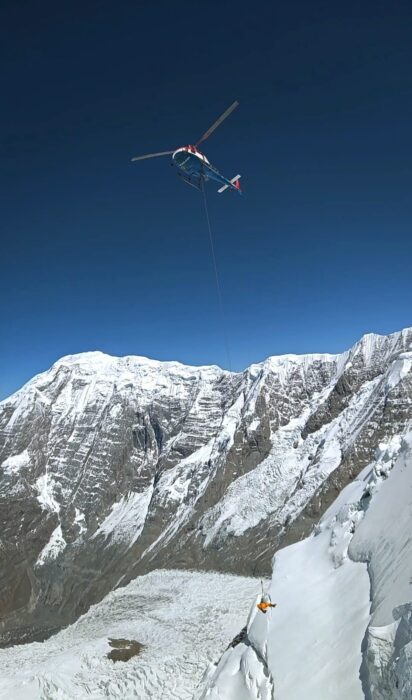
A helicopter evacuates one of the Brazilians with a long line. Photo: Piotr Krzyzowski
Bad weather is expected on Annapurna for the next several days, so the mountain will definitely close for the season. Krzyzowski will now focus on Makalu, as planned. He may return to Annapurna in future, or not.
“It is a beautiful mountain but very, very dangerous,” he says.
Krzyzowski is among the strongest 8,000m climbers these days. Last year, he summited Everest and Lhotse without oxygen or Sherpa support, climbing on his own in a four-day push.
Too many airlifts
Annapurna climbers have suggested that over 10 people were airlifted from Camp 3 this season. Some have wondered whether they were in a serious condition or whether some simply preferred to skip the dangerous descent between Camp 3 and Camp 2. This would be similar to past incidents on Everest-Lhotse, where helicopters have transported descending climbers who wished to avoid the dangerous Khumbu Icefall.
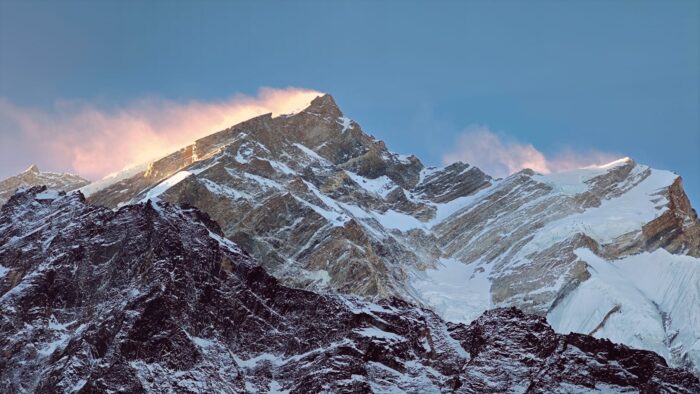
Annapurna. Photo: Piotr Krzyzowski
It is possible that all the evacuations were real emergencies, but then something was not done right on the mountain. That many airlifts suggest too many injuries, illnesses, and close calls on a mountain that really should be suitable only for the highly experienced but is increasingly invaded by guided beginners.
The issue is also a concern for insurance companies.
Insurers concerned
“This is a very grey and problematic area,” said Prateek Gupta of Adventure Sports Cover 360. “Many times, the clients or operators are not forthcoming [about the circumstances] as well.”
Gupta knows that some climbers have caught helicopter rides because they were afraid to descend through the avalanche-prone area of Annapurna. It’s not always a medical emergency. “Climbers who had insurance called the insurance companies, and some paid,” he noted.
A long line from Camp 3 costs $19,000 to $20,000 on Annapurna.
“We can do some basic checking via radio and symptoms, but we have to ultimately rely on the guide, expedition operator, and base camp sirdar,” Gupta said.
